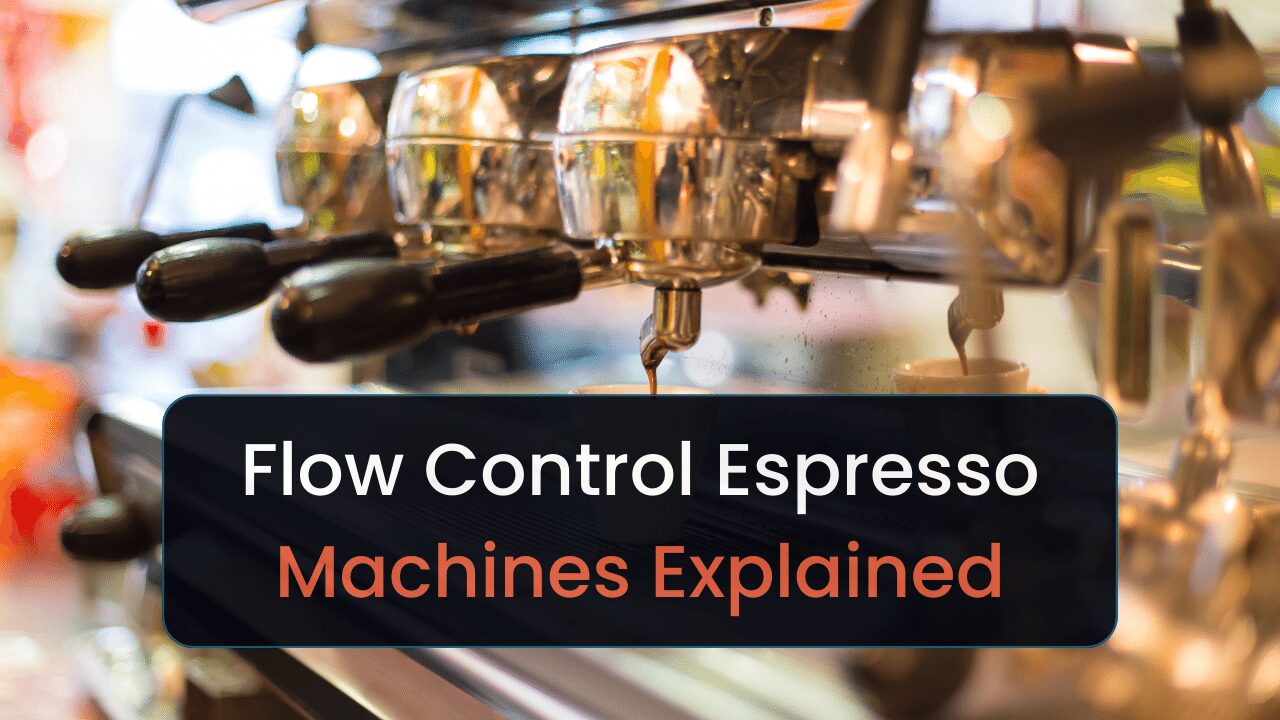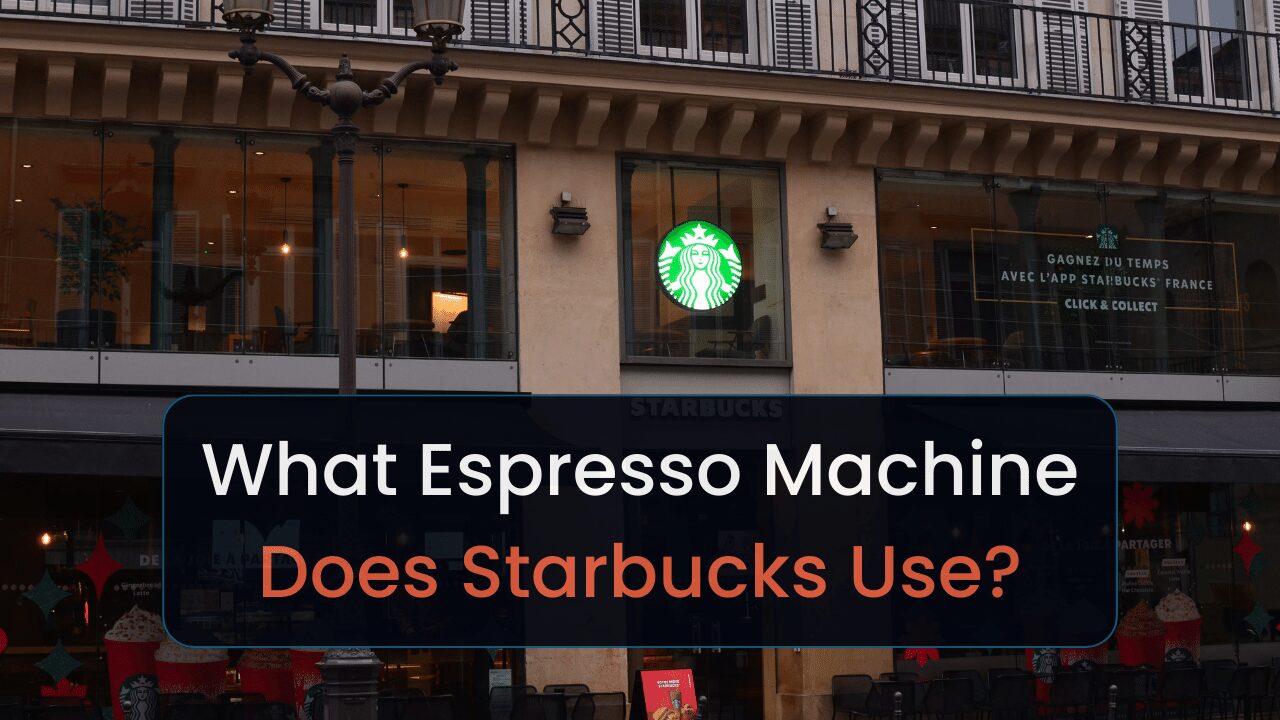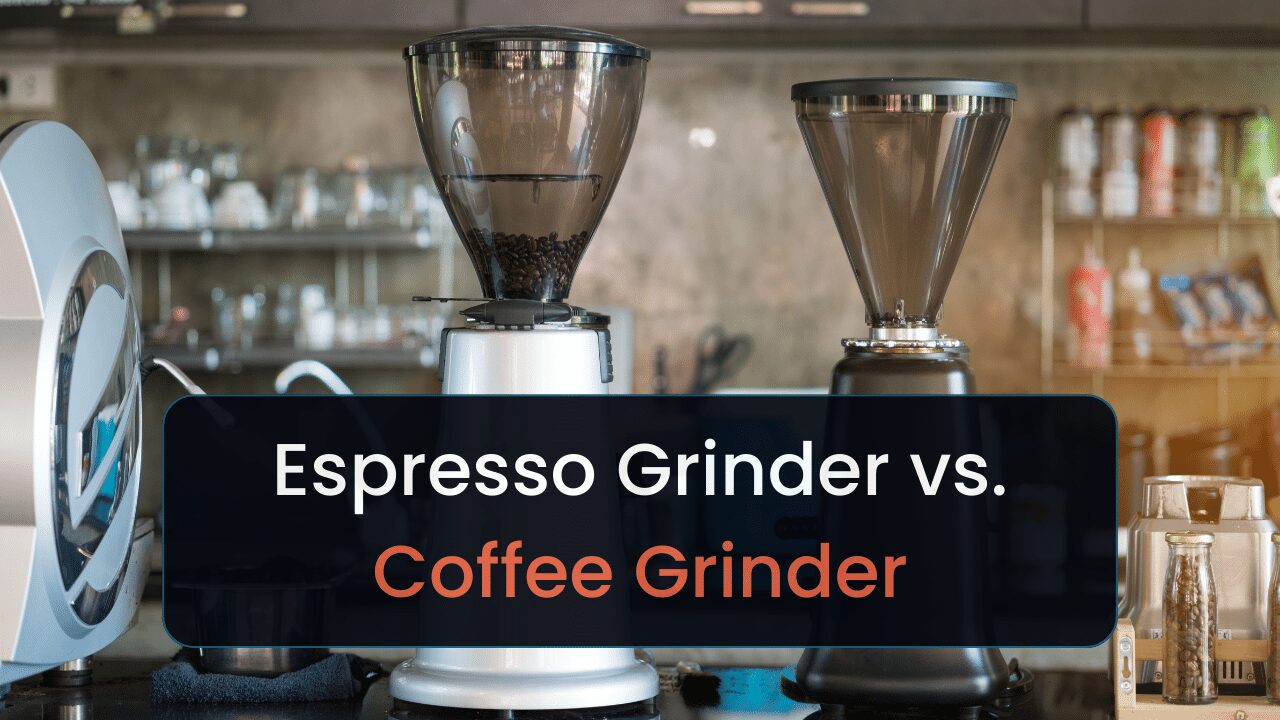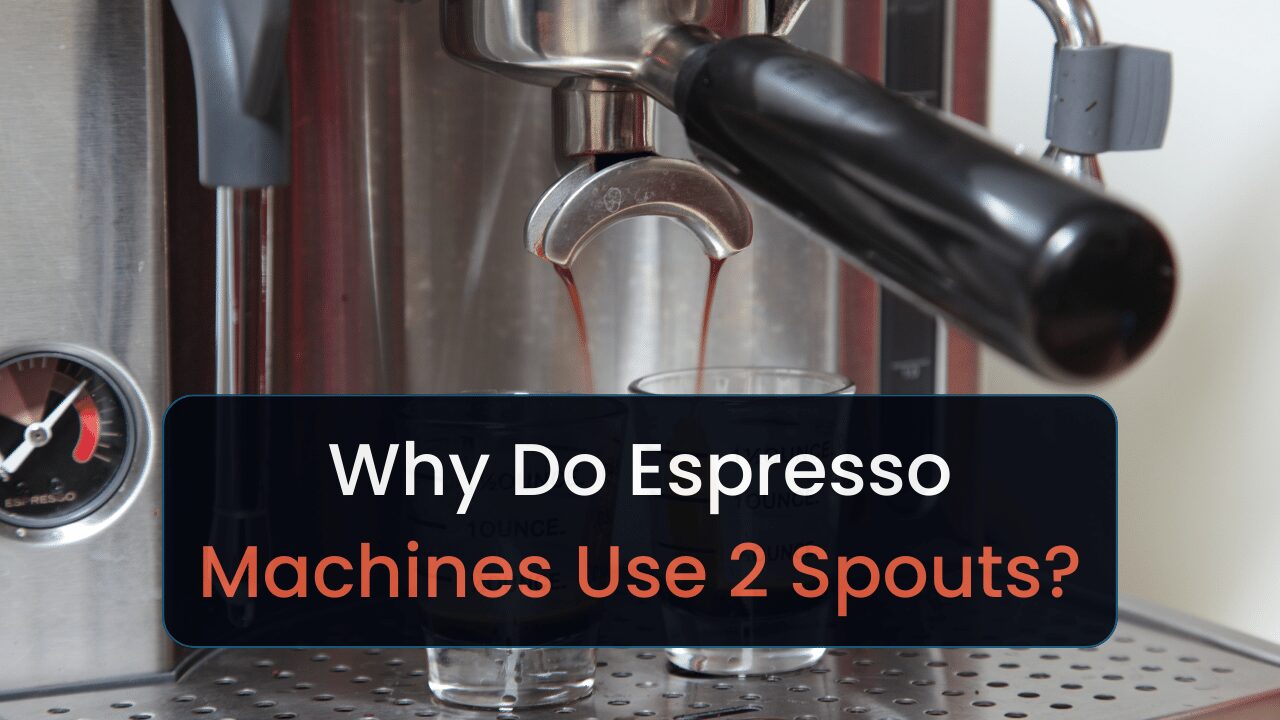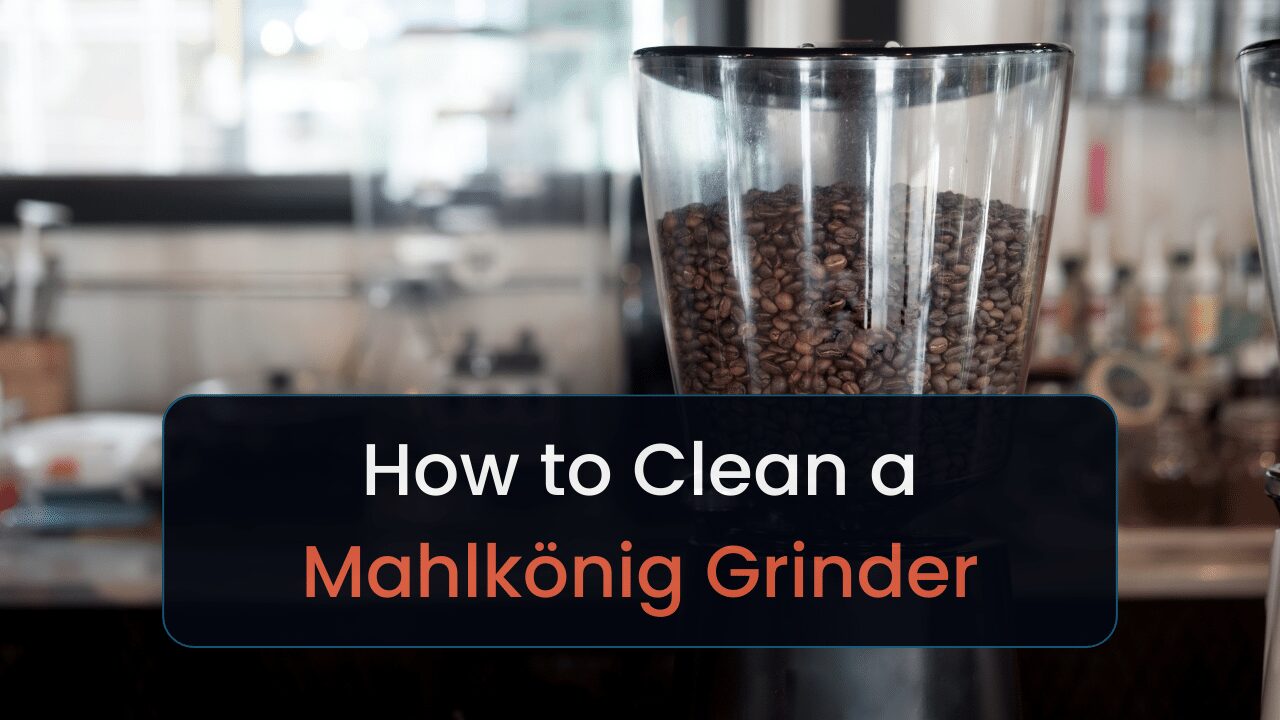This piece is an overview of the best home and business coffee grinders with a built-in timer. Keep reading to learn more.
I often want to walk away from my coffee grinder and let it do its job. That inspired me to search for a coffee grinder with a timer. This post will include my findings.
I chose the Breville Smart Grinder Pro as the top pick because testing has proved that despite not being a high-end espresso grinder, it’ll result in great-tasting espresso with some extra preparation.
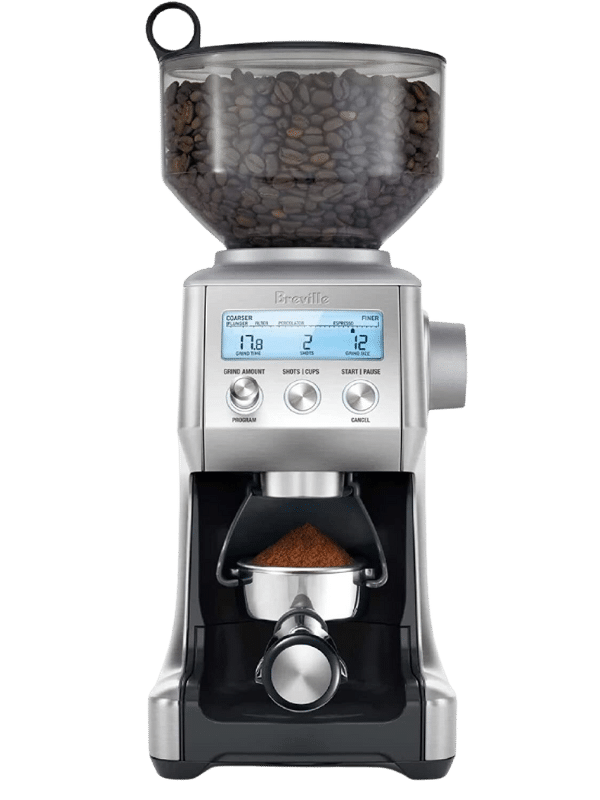
Breville Smart Grinder Pro:
Best Overall
- Price: $$
- Burr Type: Conical
- Diameter (Burr): 40 mm
- Dimensions (D × W × H): 8.5 × 6 × 15.5 in
- Hopper Capacity: 18 oz
- RPM: 450 RPM
- Warranty: 1 year
- Drinks it Can Make:
- Drip coffee, espresso, AeroPress, & siphon coffee
- Settings Type: Stepped
Such results make this grinder a fantastic choice for anyone wanting a coffee and espresso grinder that’s affordable and produces great results. You may find it too expensive, though. I’ll provide more affordable alternatives throughout this guide.
I’ll talk about the specs, pros and cons, who each grinder is best for, and any design choices that you could find useful.
Keep reading to learn more.
5+ Top Coffee Grinders With a Timer
- Breville Smart Grinder Pro: Top pick
- SHARDOR Conical Burr Coffee Grinder: Cheapest
- Baratza Virtuoso+: Best under $500
- Cuisinart Programmable Conical Burr Mill: Best programmable grinder
- MAZZER Mini Timer: Best for businesses
- Opus Conical Burr Grinder: Best grinder, UK
5+ Best Coffee Grinders With an Integrated Timer
The following sections will lay out the following facts about each grinder with a timer:
- Specifications
- Pros and cons
- Who it’s best for
- Design choices and why they’re practical
- Explanation of the pros and cons
Once I’m done criticizing all these machines, I’ll provide a buyer’s guide. Why? Because it’ll help you shop for a grinder. It will also help you understand some of the information that I provided.
Keep reading to learn more about the first option.
1. Breville Smart Grinder Pro: Best Overall
![5+ Best Coffee Grinders With a Timer in [currentyear] 1 breville smart grinder pro](https://timscoffee.com/wp-content/uploads/2023/06/breville-smart-grinder-pro.png)
| Price | $$ |
| Burr Type | Conical |
| Diameter (Burr) | 40 mm |
| Dimensions (D × W × H) | 8.5 × 6 × 15.5 in |
| Hopper Capacity | 18 oz |
| RPM | 450 RPM |
| Warranty | 1 year |
| Drinks it Can Make | Drip coffee, espresso, AeroPress, & siphon coffee |
| Settings Type | Stepped |
Pros:
- Pretty quiet
- Simple to remove the upper burr chamber
Cons:
- Not ideal for grinding super fine grinds
- Clumping is an issue
The Breville Smart Grinder Pro is ideal for folks who want a grinder with a timer that’ll grind for espresso, though it won’t do the best job doing so if you’re an enthusiast.
You can technically grind for espresso with the Smart Grinder Pro—every grinder can. But that doesn’t mean it’ll do a fantastic job. It has stepped settings (60 grind levels), which limits the fineness with which it can grind.
Espresso grinders usually have stepless (unlimited) settings, allowing you precise control over your grinds. It also doesn’t have that high of RPM. The optimal revolutions per minute for espresso is 1,000 or more.
I said, “optimal.”
The stepless settings and high RPM will primarily benefit espresso enthusiasts with refined palates. This machine and almost every other device on this list are fine for casual coffee drinkers and beginners.
It’s also excellent for beginners because of how easy it is to remove the burr champer. You grab onto a little handle and twist. Then you have access to your lower burr chamber. Such a design choice makes this machine easy to clean without additional tools.
It runs between 70 and 80 dB, making it a fantastic choice for households who don’t want to wake up their family or roommates when grinding. I wouldn’t recommend it for traveling, though. You’d want a manual grinder at that point.
Breville doesn’t offer any official single dose grinder hoppers for their devices, but I found one from a third-party site dedicated to such devices. Such a device will preserve your bean’s freshness and reduce grind retention.
Since there’s no extra beans stored in a hopper, your resulting coffee drink will taste better. And with less retention, your grinder becomes easier to clean.
This specific single dose hopper is pricey, though (more than $70). But if you care about bean freshness and want a device that’s easier to clean, it’s a worthwhile investment. It’s also usable on other Breville grinders. Thus, it’ll stick around for a long time.
While this device can grind espresso, many have complained that their portafilters have a lot of clumped grounds. Of course there is, it’s a lower-cost grinder. You’re going to encounter grinding with cheaper grinders.
Get a WDT tool and use it to break up your coffee grounds. And if you still experience espresso channeling, look to other solutions. We mention them in a separate guide.
This grinder fares well against more expensive (and popular) grinders like the Niche Zero. A YouTuber tested how espresso tasted with coffee ground in both machines and said the Breville didn’t do bad [1]
You may want a grinder with a timer that costs a lot less. I have an alternative.
2. SHARDOR Conical Burr Coffee Grinder: Most Affordable
![5+ Best Coffee Grinders With a Timer in [currentyear] 2 shardor conical burr coffee grinder](https://timscoffee.com/wp-content/uploads/2024/02/shardor-conical-burr-coffee-grinder.png)
| Price | $ |
| Burr Type | Conical |
| Diameter (Burr) | 40 mm |
| Dimensions (D × W × H) | 8.9 × 6.46 × 12.48 |
| Hopper Capacity | 8.5 oz |
| RPM | NA |
| Warranty | 400 days |
| Drinks it Can Make | Drip coffee, pour-over, and AeroPress |
| Settings Type | Stepped |
Pros:
- Affordable
- Good for coarse grinds
Cons:
- Not good for espresso or Turkish coffee
- Not an ideal grinder, in general
The SHARPDOR works best for anyone wanting an affordable grinder that includes a timer and will get the job done.
I’m not going to lie to you and tell you this is an amazing grinder. Outside the reviews, many folks have said that it’s a nightmare with static and that size distribution is inconsistent.
That’s good for coarse grounds, because you want uneven grinds. But that’s bad for espresso. This isn’t an espresso grinder, though. I didn’t get my hopes up that this would do well grinding espresso.
Why?
Because it’s a stepped grinder (31 settings) with an unknown amount of RPM. The limited settings don’t give you much control over your grind size. And the slower motor doesn’t do as good at grinding beans.
Most machines on this list have low RPMs. I won’t knock it down in this area.
Considering it’s an electric grinder that uses burrs instead of blades, it’s very affordable. It’s also good for French press, pour-over, drip coffee, and siphon coffee. Though, I’d honestly recommend saving up for any of the other machines on this list.
If you’re skeptical that it’s from an unknown brand, yet want to save money, consider the Cuisinart CBM–18N. I’ll review it in a couple of sections.
If you have some extra money to spend on a high-quality grinder, consider this next pick.
3. Baratza Virtuoso+: Best Under $500
![5+ Best Coffee Grinders With a Timer in [currentyear] 3 baratza virtuoso](https://timscoffee.com/wp-content/uploads/2023/06/baratza-virtuoso.png)
| Price | $$$ |
| Burr Type | Conical |
| Diameter (Burr) | 40 mm |
| Dimensions (D × W × H) | 6.69 × 6.69 × 12.6 in |
| Hopper Capacity | 10.6 oz |
| RPM | 550 RPM |
| Warranty | 1 year |
| Drinks it Can Make | Drip coffee, espresso, AeroPress, & siphon coffee |
| Settings Type | Stepped |
Pros:
- Single dose hoppers available (sold separately)
- Easy to find parts
- Easy to use
Cons:
- Not good for espresso or Turkish coffee
- A bit pricey for beginners
The Baratza Virtuoso+ is best for beginner and intermediate home baristas with disposable income to spend on a high-quality coffee grinder.
I say “coffee” and not “espresso” because it has stepped settings, limiting how many grinds this machine can produce. You’d want a stepless grinder for that, and those usually cost more than $500.
And since it’s not an espresso grinder, it’s also not optimal for grinding Turkish coffee. Because that requires even finer grounds.
You might have seen the “single dose hopper” in the pros and cons and scratched your head. Let me explain. Single dosers only grind the beans you’ll need. There’s no leftover beans. Thus, you’ll have the freshest coffee possible. Since your beans aren’t exposed to sunlight and oxygen.
That’s the downside with hoppers. They’re convenient for serving large amounts of people, but not for bean freshness.
The single dose hopper doesn’t come with the machine—I wish it did. But you can purchase it separately on Baratza’s website for around $25. You’ll see a lot of cheaper knockoff brands on Amazon. But I wouldn’t trust them.
When buying from Baratza, you’ll know it’s compatible. With these other single-dose hoppers, anything can happen.
This hopper will work with every Baratza model other than the Sette. Thus, if you get a new device from Baratza, you won’t need a new hopper.
You’ll find all the other parts you could need to repair your Virtuoso+ on Baratza’s website, making it easy to repair.
Speaking of parts…
Many may wonder, “Why not buy the Encore over the Virtuoso+? It’s cheaper.” First, the Virtuoso+ includes a timer, which is why you’re reading this guide. The second reason comes from the burr upgrade.
The Encore uses the M3 burr; the Virtuoso+ uses the M2 burrs. The M2 burrs are better for grinding espresso due to having sharper edges, which do a better job of shredding coffee beans into fine grounds.
Yes, this grinder can grind for espresso, but it won’t do as well as stepless grinders.
However, you could upgrade the M3 burr to the M2 burr on the Encore for $35 (plus tax and shipping). It would still cost a lot less than the Virtuoso+ if you bought the Encore plus the burr upgrade.
The deciding factor is whether you want the timer included in the Virtuoso+
You may not have enough money for either, but you also don’t want to buy the SHARPDOR. Here’s an alternative.
4. Cuisinart CBM–18N: Best Programmable Grinder
![5+ Best Coffee Grinders With a Timer in [currentyear] 4 cuisinart cbm–18n](https://timscoffee.com/wp-content/uploads/2024/02/cuisinart-cbm–18n.png)
| Price | $ |
| Burr Type | Conical |
| Diameter (Burr) | NA |
| Dimensions (D × W × H) | 8.37 × 7.62 × 12.12 in |
| Hopper Capacity | 8 oz |
| RPM | NA |
| Warranty | 3 years |
| Drinks it Can Make | French press, drip coffee, AeroPress, and siphon coffee |
| Settings Type | Stepped |
Pros:
- Affordable
- Great for drip coffee
Cons:
- Not good for espresso or Turkish coffee
- Can’t start grinding at a certain time
The Cuisinart CBM–18N is an excellent grinder for anyone who needs something cheap to grind for AeroPress, siphon coffee, French press, drip, or similar brewing methods.
It’s a stepped grinder with 18 settings. Stepped grinders, in general, aren’t optimal to use when grinding for espresso because they can’t achieve fine grounds. You’ll likely find coarse grounds mixed in, which could throw off your extraction and produce weird-tasting espresso.
The low number of stepped settings makes this grinder great for all the brewing methods I mentioned a couple of paragraphs earlier. With coarser grounds, you’ll have better extraction.
The usage of “programmable” is a bit sketchy.
With this product, it doesn’t mean that you can set it to grind at a specific time. It refers to adjusting the number of cups you want to grind for and the burr settings.
The adjustability is nice for an affordable grinder like this, but I do not like the language they use for their copy.
The term “programmable” also refers to setting the grinder for a specific amount of time.
I couldn’t find any actual grinders with timers that allow you to program them to grind at certain times of the day.
If you don’t want to go for the CBM–18N or the SHARPDOR, try searching for refurbished or used versions of the higher-quality grinders mentioned. You’ll get the cheapest grinders when buying used. But they have questionable reliability due to having an unknown history.
Refurbished is better for those who want to save money, don’t have technical knowledge of the grinders, and don’t want to deal with constant repairs. Though, finding replacement parts for the Baratza machine isn’t hard.
Anyway. I’m off track. Here’s a machine that’ll work better for prosumer or business use.
5. MAZZER MINI Timer: Best Coffee With a Timer for Businesses
![5+ Best Coffee Grinders With a Timer in [currentyear] 5 mazzer mini timer polished aluminumside](https://timscoffee.com/wp-content/uploads/2023/11/mazzer-mini-timer-polished-aluminumside.png)
| Price | $$$$ |
| Burr Type | Flat |
| Diameter (Burr) | 58 mm |
| Dimensions (D × W × H) | 13.5 × 6.75 × 18.5 in |
| Hopper Capacity | 1.3 lbs |
| RPM | 1400 RPM (50 Hz)1600 (60 Hz) |
| Warranty | 1 year |
| Drinks it Can Make | Espresso, cappuccino, flat white, latte, and Turkish coffee |
| Settings Type | Stepless |
Pros:
- Best grinder on this list for espresso
- Grinds quickly
Cons:
- Has a doser
- No electric timer
The Mazzer MINI Timer is an ideal grinder for anyone who runs a small coffee shop. It’s also a great choice for home users.
It’s a stepless grinder with infinite settings, which makes it perfect for grinding espresso and Turkish coffee. Because with unlimited settings, you can be as precise as you want with fine grinds.
The MINI Timer also has 1,400 RPM, which is optimal for grinding espresso. Since the motor runs faster, it’ll grind beans finer. It’s not the best for Turkish coffee, since that requires 3,000 RPM, but most machines don’t have 3,000 RPM.
It’s the best you’re going to get.
I wouldn’t consider this an at-home machine because it includes a dosing chamber. Businesses typically use this chamber to pre-grind many rounds of beans to dispense them for different types of coffee drinks immediately.
It also uses a hopper instead of a single doser, exposing your beans to UV rays (from the sun) and oxygen since you’ll likely leave them in the hopper. Businesses must constantly refill their hoppers, leaving this as a non-issue. But home users won’t.
And Mazzer doesn’t offer single-dose modifications, since they target businesses. I found one that some folks made on a barista forum, but it requires a lot of DIY to work [2]. I haven’t done this; thus, I can’t claim whether it’s functional.
The MINI Timer does have a timer, but it’s a switch that doesn’t label how long you set the timer for. I suppose we’re left to guess and find an optimal setting.
The Mazzer MINI Timer has 58 mm burrs, which are much bigger than any other burrs on this list. That means they’ll grind quicker—up to 1.2 grams per second—and they won’t generate as much heat.
Using larger burrs means your grinder will last longer, and you won’t damage your beans by overheating them.
If you’re after a grinder for your business, I have better recommendations in a separate guide. Because this is the best you’re going to get if you want a timer.
If you’re a home user, don’t stop reading. We have one more pick that you might like.
6. Fellow Opus Conical Burr Grinder: Best Coffee Grinder With a Timer, UK
![5+ Best Coffee Grinders With a Timer in [currentyear] 6 fellow opus coffee grinder](https://timscoffee.com/wp-content/uploads/2023/06/fellow-opus-coffee-grinder.png)
| Price | ££ |
| Burr Type | Conical |
| Diameter (Burr) | 40 mm |
| Dimensions (D × W × H) | 210 × 129 × 268 mm |
| Hopper Capacity | 110 g |
| RPM | 350 RPM |
| Warranty | 2–3 years |
| Drinks it Can Make | Drip coffee, espresso, AeroPress, & siphon coffee |
| Settings Type | Stepped |
Pros:
- Compact
- Consistent grinds
- Sleek appearance
Cons:
- Not much control over the timed stop feature
- No portafilter cradle
- Uses plastic housing
The Fellow Opus Conical Burr Grinder is best for folks in the United Kingdom, Australia, Canada, and other parts of the world, due to its wide-reaching (and generous) warranty policy.
You can use the Fellow Opus to grind espresso, but it’s not optimal. You have 41 settings (stepped) and don’t have much RPM. The former matters because you can’t get as precise of coffee grinds. And the latter is for those who are serious enthusiasts.
If you’re a casual espresso drinker, the previous paragraph doesn’t matter. However, there’s no portafilter cradle. You’ll have to hold your portafilter under the grind dispenser when it runs.
It’s a sacrifice that’s worth it.
Otherwise, this machine wouldn’t be so beautiful. Unfortunately, it’s not super durable, as well. They chose plastic over stainless steel with the housing to cut costs (allegedly). That means you have to be careful with the grinder.
You likely won’t constantly hit it, so this shouldn’t be an issue.
The biggest gripe I have with this machine is the timed autostop. It is technically a timer, but it allows you to shut off the machine after the following increments automatically:
- 30 seconds
- 50 seconds
- 90 seconds
- 120 seconds
And you have to press the start button a certain amount of times to set your timer. There’s also no screen to show you how long the timer will last. Have fun using this feature.
Due to the lack of other features, this machine doesn’t demand much space. It’s perfect for smaller kitchens.
Otherwise, various tests have shown that this grinder produces consistent grinds that resulted in great-tasting coffee and espresso. It does all this at a reasonable price tag. If you still find this too expensive, see if you can get it refurbished.
That’s all for machine recommendations. Keep reading to learn whether you’re making the right purchasing decision.
Factors to Consider When Shopping for a Coffee Grinder With a Timer
Think about these factors when shopping for a coffee grinder with a timer:
| Factor | Description |
| Burr vs. Blade | Burr grinders ensure consistent grind size. |
| Price Point | Aligns with budget and quality expectations. |
| Brand | Reflects reliability, reputation, and customer support. |
| Features | Determines convenience, functionality, and versatility. |
| Machine Size | Fits kitchen space and user needs. |
| Bean Capacity | Matches usage patterns and coffee consumption. |
I’ll dive deeper into each of these points and how essential they are when shopping for a coffee grinder with a timer. From there, I’ll explain what you’ll typically find in coffee and espresso grinders with timers.
Here we go.
1. Burr vs. Blade
- Burr: Better choice for coffee drinkers and better for coarse and fine grinds
- Blade: Best for casual coffee drinkers and coarse coffee grinds
Burr grinders crush coffee beans uniformly; blade grinders chop them unevenly. Burr grinders excel in consistency and control, suiting coffee enthusiasts. Blade grinders offer simplicity and cost-effectiveness, appealing to casual users.
Almost all coffee grinders with timers will include burrs and not blades. Despite including burrs, many of them are affordable. Are they good? Pretty good.
Pros of Burr Grinders:
- Consistent Grind: Ensures uniform extraction and full flavor.
- Adjustable Settings: Tailors grind size for various brewing methods.
- Longevity: Durable design lasts longer.
Cons of Burr Grinders:
- Higher Cost: More expensive than blade grinders.
- Larger Size: Requires more kitchen space.
- Complexity: Cleaning and maintenance demand more effort.
Burr grinders’ uniform grind and versatility justify their higher cost and complexity, ideal for serious coffee lovers.
Pros of Blade Grinders:
- Affordable: Lower price point.
- Compact: Saves counter space.
- Easy to Use: Simple operation for beginners.
Cons of Blade Grinders:
- Inconsistent Grind: Leads to uneven extraction.
- Limited Control: Fewer grind size options.
- Heat Generation: Can alter coffee’s flavor.
Blade grinders’ affordability and simplicity suit casual coffee drinkers, despite their limited control and inconsistency.
Let’s talk more about price points.
Summary: You likely won’t see a grinder with a timer that uses blades. This isn’t a point you’ll need to worry about.
2. Price Point
- Avg. Price: $50–$300
The low-end price for coffee grinders with timers is under $100. These grinders won’t have the best quality and typically are messy. Higher-end grinders, like those from Baratza, are more than $150.
Commercial coffee and espresso grinders are typically more than $700. Because these are meant to serve hundreds of guests daily.
What affects the prices of these machines?
Material quality is a key factor. Grinders with metal components cost more. They are more durable than plastic ones. Durability justifies higher prices.
Brand reputation also impacts price. Well-known brands often charge more. They offer reliability and customer trust. This trust typically translates into a higher cost.
Grind consistency is another factor. Grinders providing uniform grinds are pricier. Consistent grinds mean better coffee quality. Enthusiasts value this feature, so it increases the price.
Additional features also impact cost. For example, grinders with more grind settings cost more. More settings offer greater flexibility. Flexibility in grind size is important for various brewing methods.
Lastly, the grinder’s capacity influences price. Larger capacity grinders are more expensive. They cater to high-volume needs, like in café. Higher capacity means higher costs.
Then there’s the brand name. That’ll impact your machine price a lot.
3. Brand
The brand of a coffee grinder with a timer can impact its price due to reputation, quality, and features. Premium brands often command higher prices due to their established trust and superior build quality.
For example, Baratza grinders, known for quality and precision, might cost more. Their Baratza Virtuoso+ model, featuring a digital timer and consistent grind, is priced around $250.
On the other hand—
Cuisinart offers more budget-friendly options. Their DBM–8 model with a basic timer might cost about $60. It offers decent quality but lacks the precision of higher-end models.
Thus, brand reputation, build quality, and additional features like precise timers contribute to price variations. Buyers choose based on their needs and budget.
Another factor that’ll differentiate brands includes features.
Summary: Machines from higher-end brands usually cost more due to having a better reputation and build quality.
4. Features
These are features you might typically see in coffee grinders with timers:
| Feature | Function |
| Programmable Settings | Saves preferred grinding times |
| LED Display | Shows timer and settings visibly |
| Auto-Shutoff | Stops grinding automatically |
| Grind Size Adjustment | Changes coarseness of grind |
| Multiple Grinding Modes | Offers diverse grinding options |
| Memory Function | Recalls last used settings |
Features like digital timers and LED displays are typically found in higher-end models. Basic features like auto-shutoff and grind size adjustment are available across various price ranges.
Programmable settings, where users save their preferred grinding times, cater to those with specific, repeatable preferences, often found in mid to high-range models. However, I haven’t seen it yet.
An LED display enhances visibility of timer and settings, a boon for user convenience, commonly featured in modern grinders.
Auto-shutoff, which stops grinding automatically, is a safety and convenience feature, ideal for multitaskers and busy environments, frequently included in the basic and advanced models.
Then you’ll choose between stepped or stepless grinders:
- Stepless Grinders: Allow infinite grind size adjustments, ideal for precise, fine-tuning preferred by coffee connoisseurs.
- Better for grinding espresso and Turkish coffee
- Stepped Grinders: Feature preset grind settings, suitable for ease and consistency, preferred by casual users.
Almost all grinders with timers are stepped grinders. If you can find one with stepless settings, it’ll be perfect for espresso. Because with unlimited settings, you can make your grinds precise.
The memory function, which recalls the last used settings, adds convenience for regular users who have a consistent routine, more common in mid to high-end grinders.
These factors will affect your grinder’s size, which can prove troublesome.
5. Machine Size
Smaller kitchens need compact equipment. Large machines can be cumbersome in tight spaces. The size impacts usability and storage.
Most grinders with timers are moderately sized. They balance functionality and compactness. These grinders often fit in tight spaces or small kitchens.
Here’s another factor that’ll modify your machine’s size.
6. Bean Capacity
Large hoppers hold more beans. This means less frequent refills. This is especially useful when serving multiple guests. You grind more coffee without pausing for refills.
However, large hoppers often aren’t airtight. Exposed beans lose freshness faster. Freshness is crucial for flavor and aroma. Airtight environments help preserve these qualities.
Additionally, most large hoppers lack UV protection. Sunlight exposure damages coffee beans. It degrades their quality. Sunlight can alter flavor and aroma negatively.
Single doser grinders offer a solution. They grind exact bean amounts per serving. This maintains bean freshness. Each dose stays protected until use.
Yet, single dosers with timers are rare. All the machines I found do not include single dosers. However, brands like Baratza offer single dosers for almost all their machines (except Sette models).
Timed grinders typically have larger hoppers. They prioritize convenience over bean preservation. For optimal freshness, a different grinder type might be necessary. Consider a grinder prioritizing bean protection over convenience.
If you’re after a single doser, you may want to consider a different type of grinder.
Summary: Bigger hoppers are better for when you have guests. Smaller hoppers are better for preserving your beans’ freshness.
Other Types of Grinders to Consider
We’ve reviewed and recommended various other grinders for situations and use cases like:
- Best coffee grinder for espresso: Best grinders for using when making espresso.
- Best coffee grinder under $100: For folks on a budget.
- Best portable coffee grinder: Coffee grinders for traveling or camping.
- Best blade coffee grinder: Grinders that use blades instead of burrs.
- Best coffee maker with grinder: Coffee makers that have built-in grinders.
- Best GBW coffee grinders: Grind-by-weight coffee grinders are more precise.
- Best espresso machine with grinder: Espresso machines that include grinders.
That’s all the information I have. Now, go buy a grinder.
Conclusion
Let’s revisit our top picks:
- Breville Smart Grinder Pro: Does a great job with grinding for espresso.
- SHARDOR Conical Burr Coffee Grinder: Affordable.
- Baratza Virtuoso+: Easy to repair and from a noteworthy brand.
I chose the Breville Smart Grinder Pro because it’s from a reputable vendor known for their high-quality products. It produces grinds that are comparable to more expensive grinders while being a beginner-friendly machine.
Don’t like any of the grinders that we recommended in this post? We have more timer grinders here.

Breville Smart Grinder Pro:
Best Overall
- Price: $$
- Burr Type: Conical
- Diameter (Burr): 40 mm
- Dimensions (D × W × H): 8.5 × 6 × 15.5 in
- Hopper Capacity: 18 oz
- RPM: 450 RPM
- Warranty: 1 year
- Drinks it Can Make:
- Drip coffee, espresso, AeroPress, & siphon coffee
- Settings Type: Stepped

